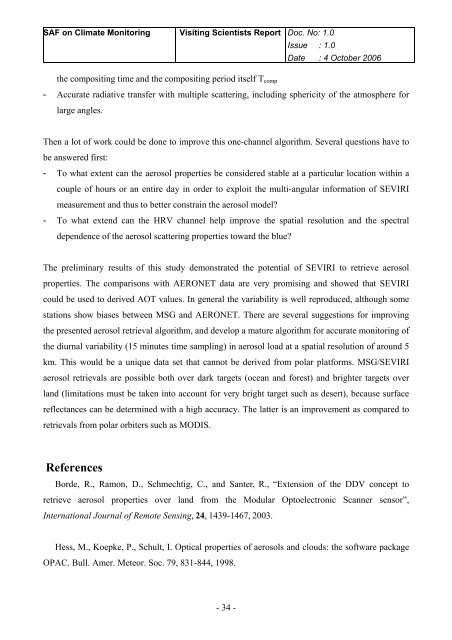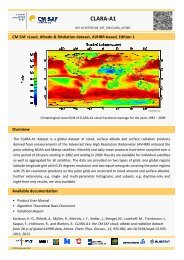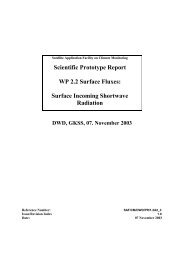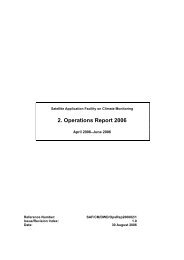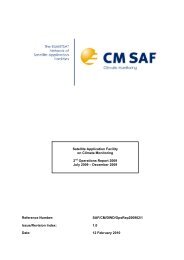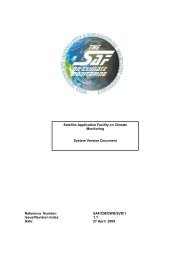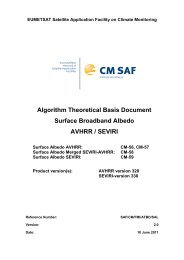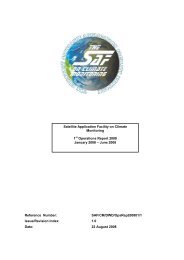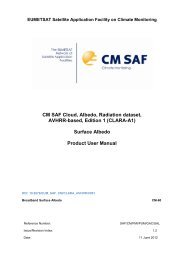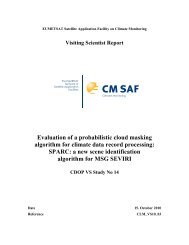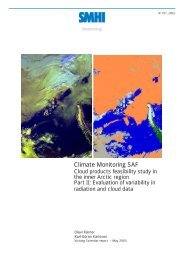Aerosol retrievals from METEOSAT-8 - CM SAF
Aerosol retrievals from METEOSAT-8 - CM SAF
Aerosol retrievals from METEOSAT-8 - CM SAF
Create successful ePaper yourself
Turn your PDF publications into a flip-book with our unique Google optimized e-Paper software.
<strong>SAF</strong> on Climate Monitoring Visiting Scientists Report Doc. No: 1.0<br />
Issue : 1.0<br />
Date : 4 October 2006<br />
the compositing time and the compositing period itself T comp<br />
- Accurate radiative transfer with multiple scattering, including sphericity of the atmosphere for<br />
large angles.<br />
Then a lot of work could be done to improve this one-channel algorithm. Several questions have to<br />
be answered first:<br />
- To what extent can the aerosol properties be considered stable at a particular location within a<br />
couple of hours or an entire day in order to exploit the multi-angular information of SEVIRI<br />
measurement and thus to better constrain the aerosol model<br />
- To what extend can the HRV channel help improve the spatial resolution and the spectral<br />
dependence of the aerosol scattering properties toward the blue<br />
The preliminary results of this study demonstrated the potential of SEVIRI to retrieve aerosol<br />
properties. The comparisons with AERONET data are very promising and showed that SEVIRI<br />
could be used to derived AOT values. In general the variability is well reproduced, although some<br />
stations show biases between MSG and AERONET. There are several suggestions for improving<br />
the presented aerosol retrieval algorithm, and develop a mature algorithm for accurate monitoring of<br />
the diurnal variability (15 minutes time sampling) in aerosol load at a spatial resolution of around 5<br />
km. This would be a unique data set that cannot be derived <strong>from</strong> polar platforms. MSG/SEVIRI<br />
aerosol <strong>retrievals</strong> are possible both over dark targets (ocean and forest) and brighter targets over<br />
land (limitations must be taken into account for very bright target such as desert), because surface<br />
reflectances can be determined with a high accuracy. The latter is an improvement as compared to<br />
<strong>retrievals</strong> <strong>from</strong> polar orbiters such as MODIS.<br />
References<br />
Borde, R., Ramon, D., Schmechtig, C., and Santer, R., “Extension of the DDV concept to<br />
retrieve aerosol properties over land <strong>from</strong> the Modular Optoelectronic Scanner sensor”,<br />
International Journal of Remote Sensing, 24, 1439-1467, 2003.<br />
Hess, M., Koepke, P., Schult, I. Optical properties of aerosols and clouds: the software package<br />
OPAC. Bull. Amer. Meteor. Soc. 79, 831-844, 1998.<br />
- 34 -


